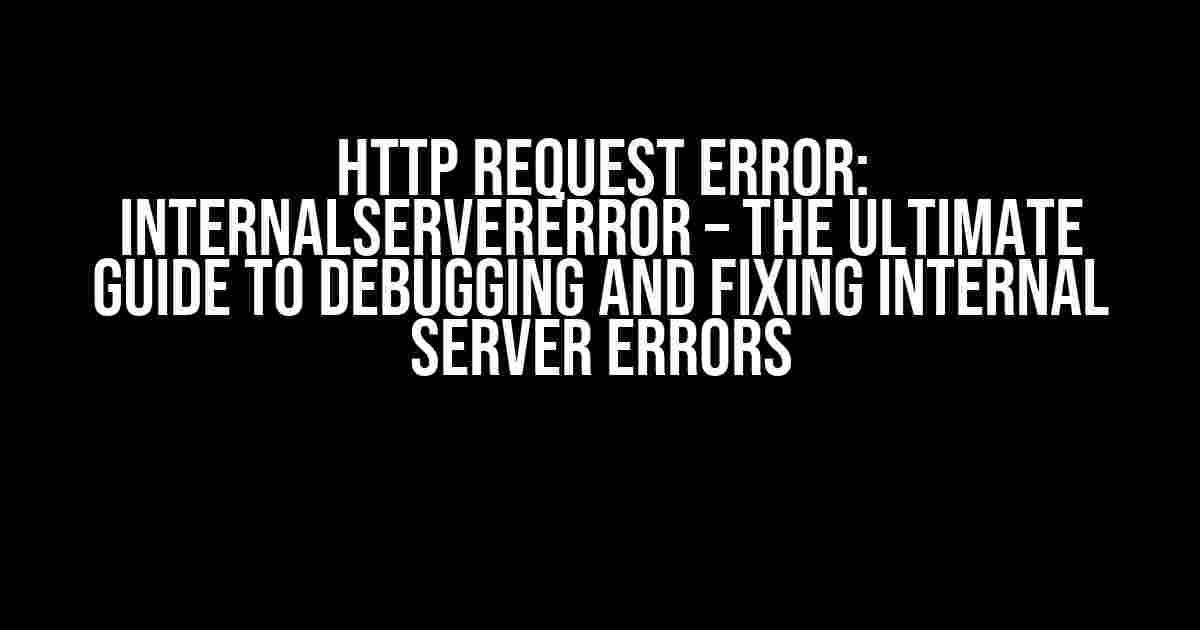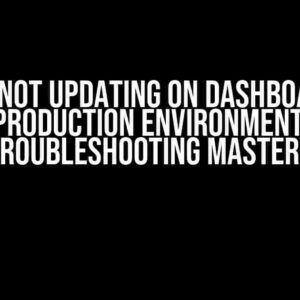Are you tired of encountering the dreaded “InternalServerError” message when making HTTP requests? You’re not alone! In this comprehensive guide, we’ll delve into the world of internal server errors, exploring the causes, symptoms, and most importantly, the solutions to this frustrating problem.
What is an InternalServerError?
An InternalServerError is an HTTP status code (500) that indicates that the server encountered an unexpected condition that prevented it from fulfilling the request. This error can occur due to a variety of reasons, including but not limited to:
- Server-side coding issues
- Database connectivity problems
- Resource constraints
- Configuration errors
- Third-party service integrations
Symptoms of an InternalServerError
When an InternalServerError occurs, you may experience the following symptoms:
- The request is rejected with a 500 status code
- The response body may contain a generic error message, such as “InternalServerError” or “An error occurred while saving the entity changes”
- The request may timeout or hang indefinitely
- Subsequent requests may also fail due to the server’s inability to recover from the error
Causes of InternalServerError: “An error occurred while saving the entity changes”
This specific error message is often related to issues with Entity Framework, a popular ORM (Object-Relational Mapping) tool for .NET applications. The error typically occurs when the application attempts to save changes to the database, but encounters an unexpected problem. Some common causes of this error include:
- Invalid or duplicate data being saved to the database
- Database schema changes that are not reflected in the Entity Framework model
- Concurrency issues, such as multiple users updating the same data simultaneously
- Underlying database errors, such as deadlocks or timeouts
Debugging Techniques for InternalServerError
To effectively debug an InternalServerError, follow these steps:
Enable tracing and logging: Configure your application to log detailed error messages and stack traces. This will help you identify the root cause of the issue.Review server-side logs: Analyze the server-side logs to identify any error messages or exceptions related to the failed request.Use a debugger: Attach a debugger to the application and step through the code to identify the exact line of code causing the error.Verify database connectivity: Ensure that the application can connect to the database successfully and that the database is in a healthy state.
Solutions for InternalServerError: “An error occurred while saving the entity changes”
Now that we’ve covered the causes and debugging techniques, let’s dive into the solutions for this specific error:
Solution 1: Validate Data Before Saving
Implement data validation checks before attempting to save the data to the database. This can be done using:
public class MyEntity
{
[Required]
public string Name { get; set; }
[Required]
public int Age { get; set; }
}Solution 2: Update Entity Framework Model
Ensure that the Entity Framework model is up-to-date with the latest database schema changes. This can be done by:
dotnet ef migrations add UpdateModel
dotnet ef database updateSolution 3: Handle Concurrency Issues
Implement concurrency handling mechanisms, such as timestamp or rowversion columns, to handle simultaneous updates.
public class MyEntity
{
[Timestamp]
public byte[] RowVersion { get; set; }
}Solution 4: Optimize Database Performance
Optimize database performance by:
- Indexing frequently accessed columns
- Optimizing database queries
- Configuring database connection pooling
Best Practices for Avoiding InternalServerError
To minimize the occurrence of InternalServerError, follow these best practices:
| Best Practice | Description |
|---|---|
| Validate user input | Ensure that user input is validated and sanitized to prevent database errors |
| Use error handling mechanisms | Implement try-catch blocks and error handling mechanisms to catch and handle exceptions |
| Maintain a healthy database | Regularly update database schema, optimize database performance, and ensure database backups |
| Monitor server-side logs | Regularly review server-side logs to identify and address potential issues |
By following these best practices, you can reduce the likelihood of encountering InternalServerError and ensure a smoother application experience for your users.
Conclusion
In conclusion, InternalServerError: “An error occurred while saving the entity changes” is a common issue that can be resolved by identifying the root cause, debugging the issue, and implementing targeted solutions. By following the best practices outlined in this guide, you can minimize the occurrence of this error and provide a more reliable and scalable application experience. Remember, debugging is an art, and with patience, persistence, and the right tools, you can conquer even the most elusive InternalServerError.
Happy coding!
Frequently Asked Question
Get the inside scoop on HTTP Request Error: InternalServerError. Find answers to the most pressing questions!
What is an Internal Server Error, and why do I care?
An Internal Server Error is an HTTP error that occurs when the server encounters an unexpected condition that prevents it from fulfilling the request. You should care because it means something went wrong on the server-side, and you might need to troubleshoot or contact your server admin to resolve the issue!
What does “An error occurred while saving the entity changes” mean?
This error message usually indicates that there was a problem when trying to update or insert data into a database or storage system. It could be due to issues with database connections, data validation, or even a full disk! Think of it like trying to save a file, but the file system says “oops, no can do!”
How do I fix an Internal Server Error?
To fix an Internal Server Error, start by checking the server logs for more detailed error messages. Look for clues like database connection issues, out-of-memory errors, or permission problems. If you’re not sure what to do, contact your server admin or developer for assistance. They can help you troubleshoot and resolve the issue!
Can I prevent Internal Server Errors from happening?
While you can’t completely eliminate the risk of Internal Server Errors, you can take steps to reduce the likelihood of them occurring. Regularly update your server software, monitor system resources, and implement robust error-handling mechanisms. It’s like keeping your server “in shape” to avoid unexpected hiccups!
What should I do if I’m a user and encounter an Internal Server Error?
If you’re a user and encounter an Internal Server Error, try refreshing the page or retrying the action that triggered the error. If the issue persists, contact the website’s support team or administrator for assistance. They’ll be able to help you resolve the issue or provide more information about what’s happening behind the scenes!




